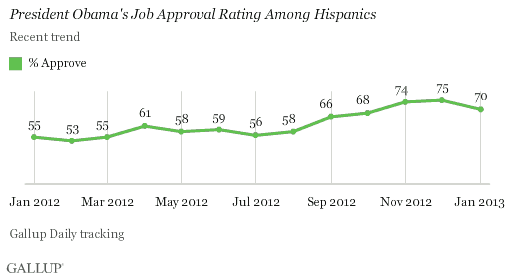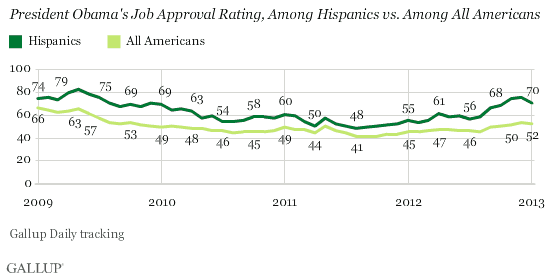PRINCETON, NJ -- In January, 70% of Hispanics approved of the job President Barack Obama was doing, down slightly from 75% in December. However, the January measure still represents an increase of 12 percentage points since last August, just prior to the Democratic National Convention.

The results are based on Gallup Daily tracking throughout January. During that time, Gallup polled 1,288 Hispanics, with roughly one-third of those interviews conducted in Spanish.
The timing of the increase in Obama's approval rating among Hispanics suggests the presidential election campaign may have been a significant factor in Hispanics' renewed enthusiasm for him, starting with the Democratic National Convention in early September through the election and the initial post-election phase. According to the National Exit Poll, Hispanics voted for Obama over Mitt Romney by 71% to 27%.
Obama's popularity is also up among all Americans since late summer, rising from 45% in August to 52% in January, though the January estimate is also down slightly from December's 53%. That seven-point August to January increase among all Americans is only about half as large as the increase for Hispanics over the same months.
Hispanic job approval of Obama is now nearly back to where it was early in his first year in office, when roughly three in four Hispanics approved of Obama. The early part of 2009 -- the president's "honeymoon period" -- was also when Obama's approval rating was highest among all Americans.

Throughout his presidency, there has been an average 13-point gap between the approval rating of Hispanics (62%) and that of all Americans (49%). Now, the gap stands at 18 points, 70% to 52%, indicating Hispanics are becoming some of the president's most ardent supporters. Among major subgroups Gallup tracks, only blacks (92%), Democrats (90%), and liberals (82%) had a higher January approval rating for Obama than Hispanics.
Implications
Even with a slight decline in his approval rating among Hispanics in January, President Obama now enjoys as strong a position with this group as he has since early in his presidency. A major priority of his second term is immigration reform, an issue of keen interest to Hispanics. Should it pass -- and the momentum toward action on immigration reform is gathering, with key Republicans in the House and Senate co-sponsoring bills -- Obama's approval among Hispanics may go even higher.
With Hispanics a fast-growing population group in the United States, both Obama and presidents who follow him will benefit politically to the extent they can win over Hispanics' support.
Explore President Obama's approval ratings in depth and compare them with those of past presidents in the Gallup Presidential Job Approval Center.
Survey Methods
Results are based on telephone interviews conducted as part of Gallup Daily tracking Jan. 1-31, 2013, with a random sample of 14,763 adults, aged 18 and older, living in all 50 U.S. states and the District of Columbia.
For results based on the total sample of national adults, one can say with 95% confidence that the margin of sampling error is ±1 percentage points.
For results based on the total sample of 1,288 Hispanics, one can say with 95% confidence that the margin of sampling error is ±3 percentage points.
Interviews are conducted with respondents on landline telephones and cellular phones, with interviews conducted in Spanish for respondents who are primarily Spanish-speaking. Each sample of national adults includes a minimum quota of 50% cell phone respondents and 50% landline respondents, with additional minimum quotas by region. Landline telephone numbers are chosen at random among listed telephone numbers. Cell phones numbers are selected using random digit dial methods. Landline respondents are chosen at random within each household on the basis of which member had the most recent birthday.
Samples are weighted to correct for unequal selection probability, nonresponse, and double coverage of landline and cell users in the two sampling frames. They are also weighted to match the national demographics of gender, age, race, Hispanic ethnicity, education, region, population density, and phone status (cellphone only/landline only/both, cellphone mostly, and having an unlisted landline number). Demographic weighting targets are based on the March 2012 Current Population Survey figures for the aged 18 and older U.S. population. Phone status targets are based on the July-December 2011 National Health Interview Survey. Population density targets are based on the 2010 census. All reported margins of sampling error include the computed design effects for weighting.
In addition to sampling error, question wording and practical difficulties in conducting surveys can introduce error or bias into the findings of public opinion polls.
For more details on Gallup's polling methodology, visit www.gallup.com.
